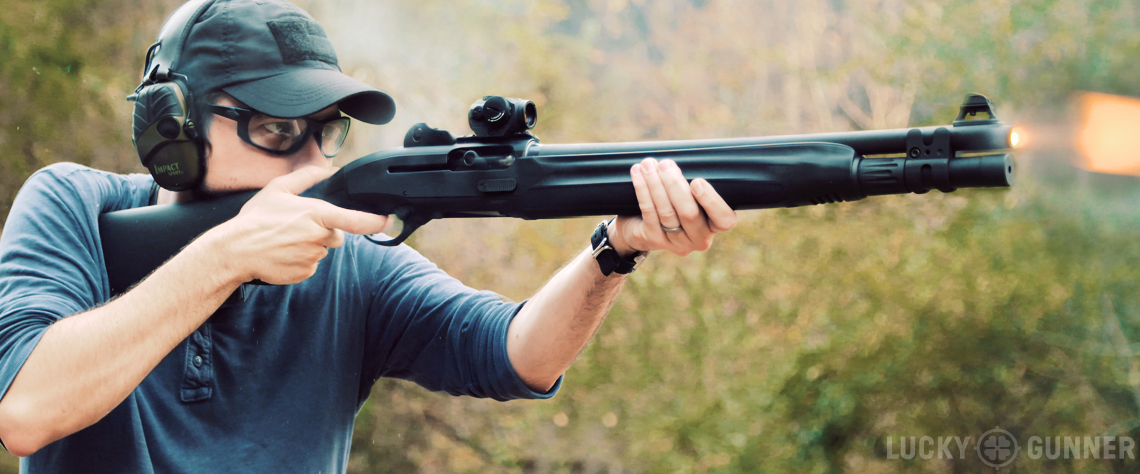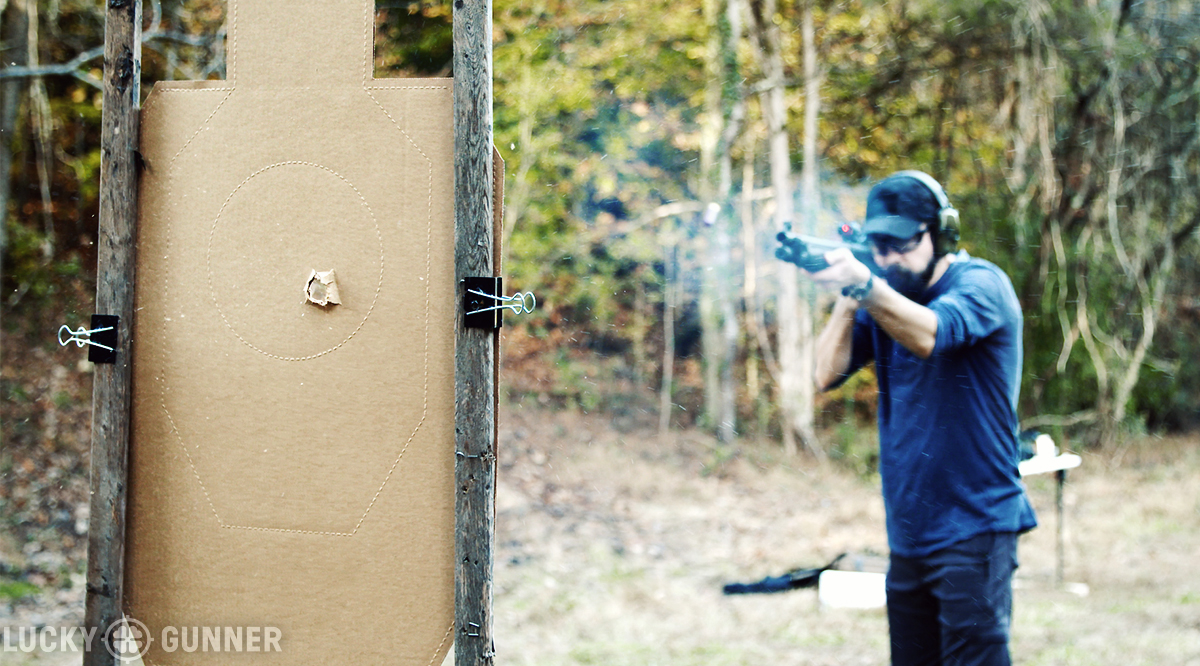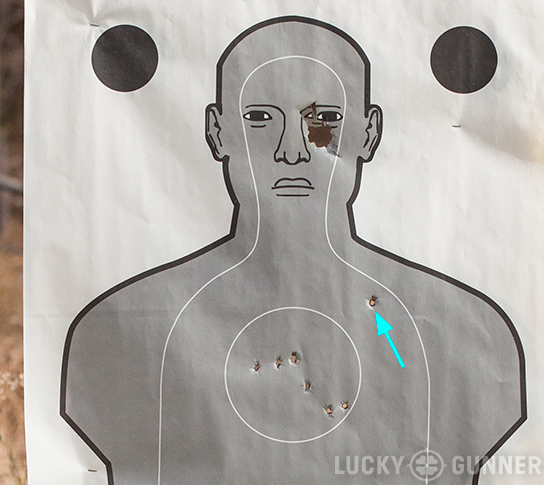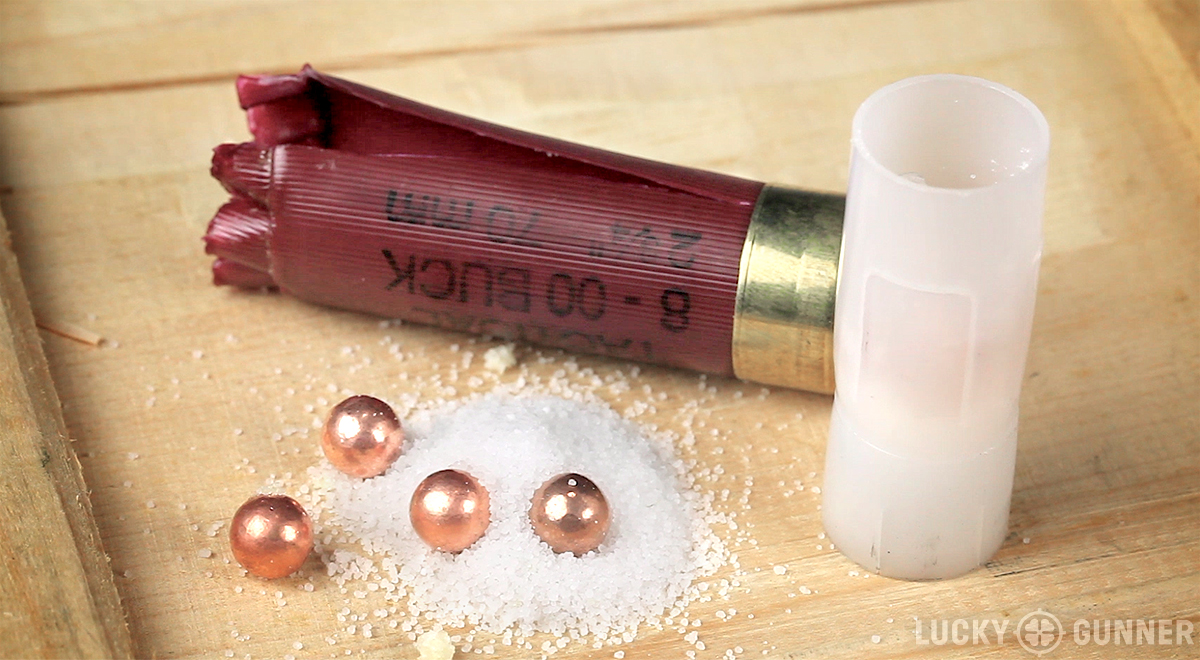In our ongoing series on defensive shotguns, the topic of buckshot will likely come up frequently. For centuries, buckshot has been the standard load whenever the shotgun is employed against human targets. It’s one of the primary reasons why, in the words of Tom Givens, “when people get shot with a shotgun, they stay shot.”
While buckshot has the ability to dominate a gun fight, not all loads are created equal. Care must be taken when choosing buckshot for defense, and the best choice might change depending on the specific shotgun used. This is better explained in pictures than words, so watch the video below for details on how to determine which defensive load to use in your shotgun.
Choosing Buckshot – The Shortcut Method
I don’t typically play favorites with defensive ammo choices, but if you watched the video, it’s pretty clear that the Federal FliteControl is an absolute game changer in the world of defensive shotguns. Performance won’t be identical in every shotgun, but inside of 10 yards, you can expect just about any 12 gauge to create a single hole with FliteControl ammo. Previously, this kind of performance could only be achieved by careful barrel selection or custom modifications to the gun.
I’m not suggesting you don’t have to pattern your shotgun if you use this ammo, but if you want to skip over the process of trying out a dozen loads of buckshot to find the right one for your gun, just grab a few boxes of FliteControl and there’s a good chance you’ll be impressed with the results. For #00 buckshot in 2 3/4″ shells, there are two versions available — an 8 pellet load, and a 9 pellet load, both sold in 5 round boxes or 250 round cases. Some boxes are labeled as “Tactical Law Enforcement” and others say “Personal Defense”, but the ammo inside is identical. Federal also makes a few #00 FliteControl loads labeled as “Vital Shok“, but these are intended for hunting, and have more recoil than the self-defense versions.
Now, before this starts to sound like a commercial for Federal, the FliteControl ammo is not flawless. I attended a shotgun class this past weekend with Tom Givens, and every student had a chance to try the Flite Control ammo in their shotgun at 15 yards. Most of the patterns were well within the 8-inch center of the target, but at least two of us experienced fliers. In the photo below, you can see my target showing a single pellet that hit high and to the right of the others.
The FliteControl wad works by holding the pellets together after they exit the barrel, and then fins on the wad cause it to gradually pull away from the shot. This separation typically occurs around 10 yards from the muzzle. After that point, the pellets begin to spread. Usually, this spread is gradual, and the pattern stays tight out to 25 yards or more, but if an individual pellet isn’t perfectly spherical, it can still stray from the group at closer distances.
My best guess for the case of the flier pictured here is that some of the buffer compound melted and stuck to one of the pellets when the shell was crimped at the factory. This gave the stray pellet an irregular shape, and it failed to continue in a straight line after separating from the wad. At 10 yards and under, I haven’t seen a round of FliteControl create anything larger than a fist-sized hole. At further distances, a tight pattern is still very likely, but fliers are possible.







I guess I am not familiar with why you would want such a tight pattern, why not use a rifled slug in that case?
The idea is that you want all of the buckshot pellets to hit the target. Every pellet that enters creates a separate wound channel. Plus, every pellet that doesn’t hit the target has the potential for collateral damage…
While a slug would be absolutely devastating at close range, in my opinion it would also be much more likely to overpenetrate than buckshot.
“Contrary to popular belief, the purpose of a shotgun in a home defense scenario is not to throw up a wall of lead when pointed in the general direction of a threat” Ok, we’re still waiting why this is false thinking, I DO want to throw up a wall of lead, please tell us why this is “contrary”.
You ever pattern a shotgun? By “wall of lead,” I mean that the common misconception is that you don’t have to aim a shotgun, just point it in the direction of a bad guy and pull the trigger. Many people think that a shotgun throws a wide spread of shot. The shot pattern does open up as distance increases, but not as much as people think. At home defense distances the pattern stays tight enough that you absolutely have to aim at your target if you want to have any hope of hitting it.
Ok, that point didn’t come across too clear with your first post. That’s fixed with a short barrel and fast spreading loads. and yes, I have and do adjust chokes..
The point of using a shotgun with multiple projectiles, buck shot or bird shot, is that in a close fast environment a close ‘miss’ can still be a hit. Having a pattern so tight that the projectiles all stay together negates the whole point of using a shotgun. I actually used a shotgun in a couple of shootings, in one of them if I had used this stuff I’d have missed the bad guy entirely.
Thanks Mike, nice to hear from someone that has “Been there, done that!”
Good information. But…in the heat of “life and death” of one having to crank up the shotgun to defend the household……………expect mayhem in what happened after the 00 rounds were “loosed” on the invasive perpetrator(s). It’ll be a loud booming experience with ordnance flying every which way AND loose.
In actuality, ordnance would not be “flying around”, as they are considered all up rounds as “ordnance”…once released from its delivery mode, it becomes a projectile.
As an aircraft being the delivery METHOD of air drop, or “released” weapons, the ordnance is still in an all up round configuration, once it leaves the vehicle. Same with rockets and/or missiles (the difference is generally propelled without or with guidance respectively. Therefore, those items all remain ordnance, as NOT fired from a case, where a projectile and delivery mode do not remain one in the same. The explosive or kinetic energy is not housed together until delivery is completed! SO, the ordnance is no longer such, it simply becomes residual components ie; case, projectile possible residue, …and from one Ordie to another, just busting your balls! AMMO!
As always excellent! Thanks.
The only advantage of the flight control shell is if I live in a large mansion and expect my shots to exceed 10 yards by a lot. Other than that, the speread of a normal shell would be better.
Another very important point is a missed shot. 00 shot will penetrate multiple interior walls in a house. This is dangerous to other members of the family. Bird shot is deadly in a few yards. A better comprimise would be Number 4 buck to the heavier bird shots. Quite leathal, but much less wall penetration..
I have to agree with the wide pattern choice here. Buck shot is designed that any ONE projectile will do the job of inflicting damage. Aimed firing is always more desirable over point shooting but a wide pattern is more forgiving of the latter when required. I personally choose #4 buck for home defense for just this reason. As stated by another commenter any load will make a single wound channel up close,
But…. a single buck shot pellet will do more damage than a single bird shot pellet.
The touchy balance is between penetration and over penetration.
Do you have any idea of the mess you are going to make of your house with a shotgun?
Not to mention the clean up and time Haz Mat will be there in your house.
You will have to replace some items, repair and paint other items a lot more than if you just use a pistol.
If you can’t shoot straight then maybe you feel the need for a shotgun but I’ll stick with my pistol, with green laser and shoot only till threat is stopped. I practice a lot and am competent with it.
A shotgun is not as easy to swing around and move with either. Its not a good tactical solution for civilian home defense. There are better options.
I would not choose a shotgun to make up for a deficiency in pistol marksmanship, I would choose it because it’s a more effective self-defense tool. And if the shotgun ends the fight quicker at the expense of needing a little bleach and spackle after the fact, I’ll take that tradeoff.
Exactly!
You’ll never find anyone who’s ever actually been in a life threatening situation involving BG’s with weapons, or other disparity of force, that was worried about having “to much gun.”
The folks who THINK they’d rather have a handgun than a shotgun (rifle, RPG, or belt-fed machine gun, for that matter); have just never BTDT!
My personal buckshot loads of choice are among the Federal Premium offerings.
Kind of going along with what you said about clean up and stuff, have you ever thought about ghosts? I’m joking but not really.
I attended a Gunsite Defensive Shotgun course in 2004 instructed by L Auerbuck . During the discussion about ammunition selection he discussed an LE shotgun product made in Salt lake City which apparently held the buckshot in a matrix from muzzle to target – shooting like a slug – then dispersing rapidly on contact with the target,resulting in wound channels more like OO buck at 15 yards. Seemed like the best of both worlds. It avoided the liability of 32 cal lead balls flying around a ‘hood, and all that “mess”.
Does any one have information on this product and its fate?
I’ve not heard of this personally, but you’ve got me curious enough that I’ll ask around. If Louis Awerbuck was talking about it, it’s probably worth looking into. What you’re describing almost sounds like some kind of frangible slug, though I doubt that would have such a significant wound channel.
Hello, I don’t know if you’re still answering these but I have a question about distances. I’m new to patterning the shotgun, but if the shell opens up at 30 feet (10 yards in the article), isn’t that a bit late? That’s a pretty big space, even for a modern home, and seems like at that distance the shell is essentially a slug? Again, I’m new to this so might not understand all of the details. Not trying to argue slugs vs shot or anything either, just the effectiveness of the ammo. Thanks!